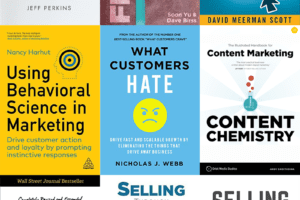Episode 64 of Yes, and Marketing
In addition to running content at agency behemoth Foundation Marketing, Melanie Deziel is an author, entrepreneur, and leading marketer with experience ranging from the New York Times to her own agency.
With a background that extensive, it’s no surprise this episode covers a lot of ground:
- Melanie’s lessons from her time running branded content at NYT, Time Inc., and HuffPost
- The story behind her book, The Content Fuel Framework
- How she explains what she actually does as a marketer
- Why journalism still matters
- The one type of content that’s getting a ton of traction right now
Listen and tap through the chapters above or read on for highlights from the episode.
Guest-at-a-Glance
Name: Melanie Deziel
What she does: Director of Content at Foundation Marketing. Author of The Content Fuel Framework.
Find Melanie on the web: Website | Foundation | LinkedIn | Twitter
Get smart: “Do fewer things at a higher quality level, consistently.”
Top Takeaway
Think like a journalist
One skill journalists have to have is the ability to speak to different audiences. “If I’m a freelancer and I’m writing a piece for one magazine or a different newspaper or a different website, they all have a different style guide,” Melanie explains. “They all have a different audience, a different way they talk to their audience, a different way they format and organize the content.”
As a result, she says, journalists get really good at “journalistic code switching,” or understanding who they’re writing for and where their content will ultimately live.
That’s a skill marketers need to develop as well. Rather than creating the same content for every channel, learn to leverage the nuances of each one and understand what sort of content will reach each audience.
Episode Highlights
How she explains what she does to the uninitiated
“When you’re talking about ‘creating marketing content for brands in a digital environment that serves specific business goals,’ it just sounds like a jargon party and no one really knows what you’re saying. So usually when I explain it, I’ll ask someone what they do first, and that allows me to frame it as a tangible example in response to what they do.
For example, I was working outside of a Starbucks and I got to chatting with a guy sitting at a table near me, and he mentioned that he worked in industrial lighting. So I said, ‘Oh, that’s interesting. So our company might work as the agency for your company and what we would do is help create content that would help your potential customers better understand how they could work with you. So maybe we create a guide for how to choose which wattage is right for your space, or an interactive map that lets you figure out based on the square footage, how many different lighting sources you need to suit your needs. We would help you create content like that, so that you could add value to your customers and hopefully attract new customers who are looking for that kind of information.’”
What it means to run branded content at the New York Times
“A brand would come to the New York Times and say, “I wanna create something that your audience likes. I wanna speak to your audience in some way,” and it was my job to act as a translator and help find that tiny part of the Venn diagram that overlapped things our audience is interested in reading content about, and this brand’s goals and expertise. I would find the middle of that Venn diagram—what’s the thing that we can help them create that will meet their brand goals, but also be interesting to our audience?”
Is journalism dead?
“Journalism has become the victim of whatever shiny new object there is in marketing, where you get all those articles that are like, ‘Is TikTok killing… ?” …But the reality is, if you look at even the non-journalism things that you may be consuming, so much of that stems from journalism. When you’re hearing someone talk on the radio and they’re talking about news, where do you think they’re getting that? We call it a rip and read: they rip out the page from the newspaper and read it on the radio. When you look at the blogs that you may like, the only reason they know what happened on the red carpet is because reporters were there reporting. The only reason they know what happened at the game is because someone was there reporting on it.”
Why journalists matter more than ever
“When the country was first founded and there were 112 people in your town, you didn’t need reporters because you could witness firsthand everything that was happening in your town, and what was happening three states away didn’t matter to you. It didn’t affect you. And that’s just not the case now. There’s so, so much happening and it’s all connected. It affects us in so many ways.
So yeah, we absolutely need folks who are trained and responsible—hopefully doing things ethically—and out there finding information that is important to us, that does affect the way we govern ourselves, the way we make choices for our family, the health choices that we make—somebody’s gotta be out there getting that information and sharing it with us.”
The latest content trend
“One thing that’s working really well right now is instructional content. This started at the early parts of the pandemic, when we saw huge increases for search terms that included things like ‘how to,’ ‘instruction,’ ‘tutorial,’ ‘DIY.’ This pandemic has unlocked a level of self-confidence in people that either out of necessity or curiosity, they are trying new things—they are doing things themselves that they would have hired out before, they are experimenting with new hobbies, they are fixing things… So instructional content where you’re providing instructions, you’re providing a guide, or you’re providing steps in a process continues to traffic fairly well.
Ask yourself, ‘What can I teach my audience? What can I teach them how to do? What can I coach them through doing? What can I help them accomplish?’ Because that kind of stuff, there’s a hunger for it now.”
One easy writing trick
“Stop in the middle of a sentence or in the middle of a thought because that way, when you come back to start again, you already know where you’re going to pick up. Otherwise it’s like staring at a blank page—like, okay, what do I write about now?—whereas if I would stop in the middle of a paragraph, I’d come back and realize, oh yeah, I just got to wrap that up, make a closing there, and then I already have momentum.”
How to get started with content
“One of the easiest areas to get started is with whatever your version of a testimonial is. So if you have case studies or a client’s success stories or testimonials or whatever it might be, start there and try to infuse more story into it. Instead of just sharing a quote and the name, really dig in, talk to that person, interview them, understand what was at stake for them, talk to other people in their lives. Be a reporter, dig in a little bit and try to take a more narrative approach.
Most of us across the organization already understand the value of a case study or a client story or a testimonial—we see the sales value in that. So if you start in that area and create some really good testimonials, some more narratively driven stories, it’s easier to get buy-in to take steps beyond that.”
Top Quotes
Melanie:
“It’s helpful sometimes to take a step back and think, am I not meeting the expectations, or are the expectations no longer serving me?”
“In marketing sometimes there’s a one-size-fits-all approach, like ‘I’ve created this one thing and now I’m gonna put it in all these places.’ And sometimes that same stuff doesn’t belong in all those places. It belongs in some strategically chosen subset of those places instead.”
“If you can empower folks to achieve something that they want to do, then you’re gonna be the first person they think of when they hit a roadblock or when they have some tangential thing that also needs to get done.”
“Do fewer things at a higher quality level consistently, rather than try to bite off more than you can chew. You can always add on. but it does something to your audience and to your own morale when you have to cut back.”
“If you don’t feel pressured to convert five minutes after you publish a blog post, you’re going to create a better blog post because your priority is going to be providing something of value instead of providing a strong call-to-action.”
“You have more ideas than you think you do.”
“The biggest shock for me coming into the marketing world was discovering that people view good ideas as something that’s scarce.”
Learn More
Melanie’s current top read: Invisible Women by Caroline Criado Perez



